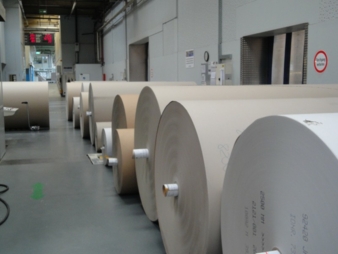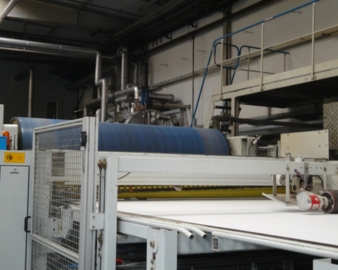01/10/2015 — auf Deutsch lesen
A belt that saves time and money
Since October 2014, the box plant in Werne is using the innovative upper belt Conducto 3313 made by GKD – Gebr. Kufferath AG in the heating section. Its open mesh construction allows immediate, full-surface evaporation of steam from the corrugated board in the heating section. An experience report.
New GKD heating belt gave a convincing performance at Klingele. Productivity, quality and flexibility are key factors in securing the Klingele Group's rank among the five largest producers of corrugated board and corrugated packaging. The family-owned company, now in its third generation, distinguishes itself through continuous high investments into new technologies that bring tangible added value for its customers and reduction of impact on the environment.
In Werne, the most recent of the four German box plants, this innovative company has been working since 2013 according to the lean management principle. This puts the focus on increasing overall equipment effectiveness as well as comprehensive planning and control of all processes. The consequence of this is that existing machinery is also being specifically optimised. Since October 2014, the box plant in Werne has therefore been using the innovative upper belt Conducto 3313 made by GKD – Gebr. Kufferath AG in the heating section.
Its open mesh construction allows immediate, full-surface evaporation of steam from the corrugated board in the heating section. The result is an optimisation of production efficiency through considerable savings in terms of glue consumption, steam energy and cleaning costs. In addition, the special mesh construction of polyester, aramide and bronze combines full protection against electrostatic discharge with long lasting consistent robustness of the belt.
Founded in 1920, the Klingele Group with its head office in Swabian Remshalden-Grunbach is today one of the leading independent producers of corrugated board packaging solutions. The group comprises a total of 16 locations in Europe and Africa. In 2014, around 1,250 employees generated a turnover of over 360 million euro. A large portion of company earnings are consistently reinvested in expansion and modernisation. The main focus of this reinvestment is on improving capacity and quality while at the same time reducing energy consumption.
In the last 15 years alone, the volume of investment amounted to 334 million euro. Overall production capacity of the corporate group is 540 million square metres of corrugated board and 400,000 tons of corrugated base paper. Following the earlier establishment of box plants in Grunbach (near Stuttgart), Delmenhorst (near Bremen) and Hipoltstein (near Nuremberg), in 1968 the box plant in Werne (near Dortmund) was founded.
This production works, with its state-of-the-art machine park and 213 employees working in three shifts a day, has an annual corrugated board production capacity of 135 million square metres. 60 percent of the products go to the regional food-processing industry; the remaining 40 percent supply the mail order sector. To meet the high demands of customers from the food-processing sector, the box plant has taken on a pioneering role in terms of hygiene: it has certification to the internationally leading packaging standard BRC/IoP for hygiene and product safety. Furthermore, all Klingele plants have a certified energy management system, and certification according to an environmental management system is in the pipeline.
Klingele's aspiration to transparency in the interests of process improvement is reflected in the lean management system that was introduced in Werne at the end of 2013. Now, in close collaboration with customers – especially those from the fast-paced and demanding food-processing industry – the company is working on networked planning and control of its processes. Overall equipment effectiveness is calculated and optimised on the basis of the key indicators system availability, system efficiency and quality. The heart of the production in Werne is the corrugator from the company BHS. It produces the flute sizes B, C, E, F as well as the new D Flute in a width of 2.8 metres. Due to this wide range of products, the corrugator, a machine specifically designed for large volume production at 400 metres per minute, actually only runs at an average speed of 250 metres per minute.
The high percentage of food-processing customers explains why the flute sizes B and C are the ones most frequently produced in Werne. This makes for demanding production conditions, which the box plant responds to with high investments in the corrugator at an almost yearly rate. Thanks to the introduction of an additional BHS control system, the corrugator now has sensors in many sections of the line that collect and use data to optimise parameters and thus to improve process stability and, with it, the quality of the products. For the customers, this means greater speed and reliability of delivery. A significant role in the quality and productivity of the complete system is played by the heating and traction section. Perfect glueing, fast drying and reliable directional stability are the key success factors here.
The heating section of the 140-metre-long BHS corrugator in Werne consists of 21 peripherally drilled hotplates with very small, sophisticatedly controlled steam chambers. It has three independently addressable sections, which means that all corrugated board grades can be produced, thus ensuring an optimum of flexibility in the product range.
For the drying and glueing of the steam-heated single-face corrugated board with the outer liner, the Werne box plant tested the innovative GKD upper belt type Conducto 3313 in its heating section. Neither the previously deployed spiral screen nor the subsequently used conventional fabric belts had succeeded in meeting Klingele's expectations for a combination of robustness, air permeability, form stability and self-cleaning properties. It was through a technical report that the company became aware of the GKD belt, and got into contact with GKD.
The process belt specialists organised an opportunity for Klaus Lüke, Head of the Central Technical Department of the Klingele Group, to visit a competitor who was using the belt and examine it in action. "After that, it was decided that Klingele would test this belt." The demands of the Werne box plant on the Conducto 3313 were complex. The belt was expected to perform with consistent reliability for the whole range of products, from 80/90 gram paper through to heavier grammages.
The heating belt needed to prove an optimum of reliability in discharging season-related electrostatic charging and in withstanding heat and mechanical strain. Apart from abrasion resistance, the company also had demanding expectations regarding the form stability of the belt, and the duration of its dimensional stability. In addition, the weight, air permeability and easy cleaning properties of the upper belt were crucial factors. Fast delivery and trouble-free commissioning in October 2014 were also winning arguments for the new belt in the eyes of Plant Manager Amir Mirsakarimi.
In its eight-month runtime at Klingele, the belt did not once require cleaning, much in contrast to its predecessors. For Amir Mirsakarimi a distinct advantage: "Previously, cleaning the upper belt always meant up to ten hours of downtime. So not having to clean the belt really saves us time and money." He would, of course, prefer it if the belt were self-cleaning. "But that only works in specific parts," he explains. "At the radii, where the belt bends, the glue often flakes off on the smooth monofilaments." However, thanks to the specific mesh construction of the heating belt, the glue has so far also not caused any appreciable soiling on the belt.
At the same time, process reliability has increased, since the belt itself has so far not triggered any downtime. A decisive factor for process efficiency is the open mesh structure of the Conducto 3313, which, thanks to an air permeability CFM rating of 600, allows immediate escape of the steam. "The belt is far more air permeable than the conventional fabric belt that we were using previously. This means that it can be run with much less heat," says Klaus Lüke, praising the new belt. Glue consumption has also been reduced, because thanks to the fast evaporation of the steam the adhesive sets faster. The lower steam pressure has reduced the expenditure for the necessary heat energy by about 10 percent.
Furthermore, product quality has increased. "The corrugated board is somewhat stiffer because it's drier," says Plant Manager Mirsakarimi. And he adds: "Because we can operate with less glue and heat, and because the corrugated board is drier, it can be processed more efficiently." However, in view of the fact that the belt was put into operation at the same time as the new process control system, Amir Mirsakarimi is reluctant to ascribe improvement in flatness, for example, exclusively to the new belt. The process has indeed become faster, but "We can't say yet whether this is due to the belt or the process control," he explains. What is definitely an advantage is that the belt reacts adaptively to the control system and the two work well together. Klaus Lüke adds: "There are a number of parameters in our 140-metre-long line that can influence flatness. So we can't draw any definitive conclusions about the belt yet. But it is a fact that process reliability has been increased by the GKD belt because it doesn't soil."
The mesh – highly air permeable and with a thickness of only four millimetres considerably thinner than other conventional products on the market - does not saturate itself with moisture and thus maintains better traction. "Right at the beginning there was relatively heavy wear at the edges," Amir Mirsakarimi recalls. But the specific mesh construction of a polyester-aramide filament system proved itself by quickly resisting the start-up wear, thus promising a long life cycle for the belt. This was a cause for satisfaction for Mr Mirsakarimi: "The belt has not changed in terms of its properties." His expectations regarding the life cycle of the GKD belt: "60 to 70 million linear metres is realistic; 100 million linear metres would be preferable."
Thanks to its robust construction, the Conducto 3313 is specially designed to meet sophisticated thermal and mechanical requirements. In addition to its mechanical stability and tensile strength, it also performed convincingly at Klingele in Werne in terms of its long-term cross-stability, optimal flatness and reliable tracking. Continuous woven-in bronze wires in the running direction reliably prevent electrostatic charging.
[ www.gkd.de]





